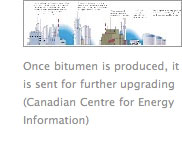| Upgrading is done in two stages: The first stage involves breaking up the molecules by “coking”, (also known as hydro-cracking or thermal conversion), hydro-processing or a combination of the two. Coking removes carbon, while hydro-processing adds hydrogen. Coking results in a byproduct that can be used for other industrial applications like feedstock in coke ovens for the steel or metals industries, heating or power generation purposes, electrode manufacturing, or chemical production. |
 [1] [1] |
The hydro-cracking process is a catalytic conversion process to crack oil molecules into smaller, refinery-ready products by reacting hydrogen with the oil under high temperatures. (Catalysts are typically metal-based materials formed into small pieces often shaped like beads or pellets.) When large hydrocarbons come into contact with a catalyst, they react by breaking down into smaller molecules with the hydrogen then bonding into the molecules. Catalysts allow some molecules with specific sizes and shapes to pass while holding others back to continue reacting. Although this process is more expensive than coking, it produces a higher yield of product from a given volume of bitumen.The second stage involves stabilizing the products and removing impurities like sulphur through a process called hydro-treating. Hydro-treating stabilizes the crude oil by adding hydrogen to some unsaturated molecules, preventing the produced crude oil from continuing to react and change its chemical composition on its way to final refining. Hydro-treating also reduces the sulphur and nitrogen content of both the crude oil and the final fuel products produced so they produce fewer emissions when burned by the end consumer. The hydrogen used for both hydro-processing and hydro-treating is made from natural gas.Hydro-treating involves mixing heated hydrocarbon feedstock with hydrogen at high pressure and temperature allowing the various petroleum liquids to pass through separate towers and flow around special catalytic pellets.
The process results in various hydrocarbon products that can be blended together or sold or used separately. The final product of upgrading, known as synthetic crude oil or upgraded crude oil, can be used by many refineries as a replacement for conventional light, sweet crude oil. |
